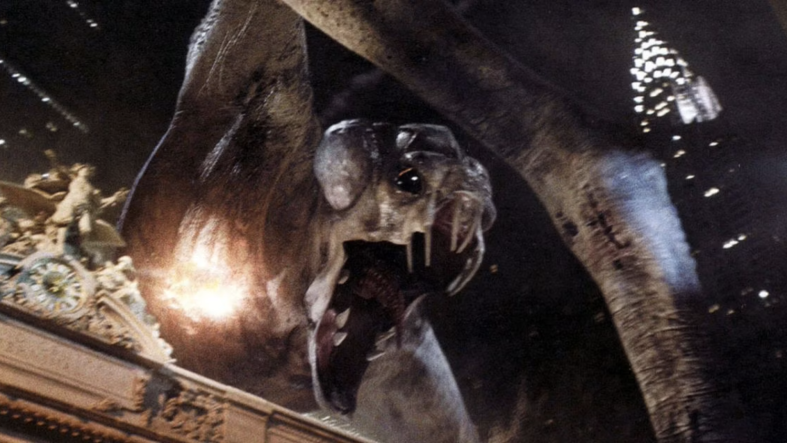‘Cloverfield’: America’s Post 9/11 ‘Godzilla’

In 1945, the United States military dropped two atomic bombs on two of Japan’s most heavily populated cities: Hiroshima and Nagasaki. This event forever changed the world. This was reflected in the media, with films such as the 1954 Japanese film Godzilla. What became one of the world’s biggest tragedies would become one of the most iconic monsters to hit the silver screen. The film depicted nuclear devastation through black-and-white film, with Godzilla‘s beaming atomic roar terrifying Japan and destroying villages. Godzilla represented the fear of Japan being powerless against atomic weapons and its long-lasting effects on civilization and the environment.
Art reflected terror again after the events of an American tragedy. In 2001, when two hijacked airplanes crashed into the Twin Towers, the American public too felt helpless against an act of terror with feelings of powerlessness dominating the country. With the increased accessibility of technology, people easily captured footage of the planes hitting the Twin Towers, creating a traumatic event with various viewpoints and perspectives relating to its broad impact on multiple individuals. Camcorders became a substantial part of the visual language of Cloverfield, channeling all of the amateur news footage that arose during 9/11 as a way for this new monster movie to channel this traumatic event.
Also Read: Monstrous Longing in Two Queer ‘Frankenstein’ Adaptations [Abibliophobia]
Cloverfield begins with a man filming a party before reports of destruction and death interrupt the celebration. But quickly, our leads are trying to survive, while documenting the destruction of New York City along the way. The monster is shown in glances and in the aftermath of destruction, with near sightings building dread, propelling the protagonist forward. Focusing on the core emotion of these events and utilizing a monster as the antagonist allows viewers to be united by fear and highlights the importance of coming together in moments of terror.
The monster is widely believed to represent the terror and destruction of 9/11. Cloverfield depicts New York’s destruction through the point of view of a camcorder, with the first look at the monster captured and displayed as news footage. Much of the camerawork replicates what happened when the World Trade Center was struck with people covered in soot and first responders rushing into the unknown to save those caught in the crosshairs of a catastrophic event. Like the film’s protagonist, the citizens of New York had a peaceful day interrupted by an unforeseen terror.
As a way for Japan to grapple with the devastation the nuclear bombings had on their homeland, Godzilla was created less than a decade later as a metaphorical response to these bombings. In the film, Godzilla attacks without prejudice, spreading nuclear fallout wherever he roams. Godzilla attacks civilian populations before provoking a military response which would only prove ineffective. The citizens feel helpless against this creature and even link it to mythic tales. Godzilla represented the fear of future nuclear attacks and the following radioactive fallout. Even certain shots in the film make Godzilla resemble a nuclear bomb.
Also Read: Ranking the Most Disturbing Deaths in ‘Trick ‘r Treat’
The biggest link to the metaphor of the atomic bomb of 1945 is the film’s main scientists creating a device that evaporates the oxygen from water, creating a machine more troubling than the devastation Godzilla represents. Despite the film ending with Godzilla’s defeat, the viewer feels apprehension as the survivors wonder if the effects of nuclear testing will produce another monster for them to grapple with.
What makes Cloverfield the American take on Godzilla is how the filmmakers utilized monster imagery to represent an act of terror on an innocent population. Before each film starts, audiences hear the monster’s roar; you don’t see the monster but feel its presence catching glimpses of its fighting back against the military and its impact on the city’s residents. The scale of these events remains at a human level. Each monster towers over the cities and their populaces, tearing down everything in its wake.
Also Read: ‘Invisible City’: Brazil’s Answer To Religious Horror
Cloverfield replicates Godzilla’s idea of personifying an instance of unpredictable terror into a physical form and how humanity is powerless under such a threat. Godzilla became an allegory for the spread of radiation in Japan and the danger of nuclear weapons, while Cloverfield represented the unpredictability of terror and how even quiet moments can quickly turn into devastation. Cloverfield also illustrated how your trauma can be captured forever when everything is monitored and filmed.
Cloverfield serves as an adequate evolution of the classic monster movies by reflecting the anxiety and fears of a nation when facing a seemingly unbeatable force of evil. Through these films, the once-separate lines between horror and reality become blurred. By carefully revealing these respective monsters, these films focus on their destruction rather than the monster’s form, which helps relate to their inspirations as both Hiroshima and 9/11 occurred without warning. Humanity had to react to the effects of terror rather than the source. Cloverfield became America’s Godzilla by reflecting how the technology of the time shaped the viewpoint of the tragedy and the way citizens can’t help but film the spectacle of destruction, even if it means capturing their darkest moments the same way they capture their most cherished ones.
Categorized:Editorials

